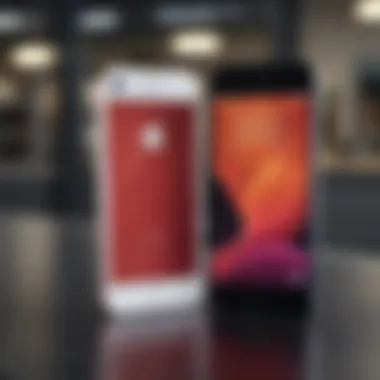iPhone SE vs iPhone 6: A Comprehensive Comparison


Overview
In this comparative analysis, we examine two noteworthy models from Apple's smartphone lineup: the iPhone SE and the iPhone 6. Both devices, while bearing Apple's hallmark design elements, cater to different market segments and user preferences. The goal is to showcase not only the similarities but also the distinctions that may influence a buyer's decision.
The iPhone 6, launched in 2014, was pivotal in setting a standard for larger smartphones, featuring a sleek design and a notable increase in size compared to its predecessors. On the other hand, the iPhone SE, released in 2020, sought to combine modern performance specifications with a compact form factor that harkens back to the iPhone 5s, aiming to attract those who favor smaller screens.
This analysis will delve into key aspects such as design, performance, camera quality, battery life, operating systems, and pricing, enabling consumers to make informed choices based on their specific needs and usage scenarios.
Features & Specifications
iPhone SE
- Display: 4.7 inches Retina HD display with True Tone
- Processor: A13 Bionic chip
- Camera: 12MP wide camera, supports Portrait mode and 4K video recording
- Battery Life: Up to 13 hours of talk time
- Storage Options: 64GB, 128GB, 256GB
- Operating System: iOS (latest updates available)
iPhone
- Display: 4.7 inches Retina HD display
- Processor: A8 chip
- Camera: 8MP rear camera, 1.2MP front camera
- Battery Life: Up to 14 hours of talk time
- Storage Options: 16GB, 64GB, 128GB
- Operating System: iOS (limited updates compared to newer models)
Pros and Cons
iPhone SE
Pros:
- Powerful A13 Bionic chip, capable of handling demanding tasks
- Compact size suitable for one-handed use
- Excellent camera quality for its class
- Regular software updates from Apple
Cons:
- Smaller screen size may not appeal to all users
- Lacks some premium features of flagship models
iPhone
Pros:
- Larger screen for media consumption
- Slim design with premium feel
- Affordable option for budget-conscious buyers
Cons:
- Older processor may struggle with multitasking
- Limited software support as it is an older model
User Experience
User feedback for both devices reveals distinct preferences. Many iPhone SE users appreciate the device’s speed and responsiveness, especially given the A13 chip's performance. One user noted, > "I can run games and apps without noticing any lag, which is impressive for such a compact phone."
In contrast, some iPhone 6 users express satisfaction with the larger screen size. A user commented, "Watching videos on the iPhone 6 is enjoyable due to the bigger display." However, the frustration regarding the aging hardware and limited updates cannot be overlooked.
Buying Guide
When considering whether to buy the iPhone SE or iPhone 6, potential buyers should factor in the following:
- Performance Needs: If you require a device for gaming or heavy app usage, the iPhone SE is the superior choice due to its advanced processor.
- Budget Constraints: The iPhone 6 may be more appealing for those on a tight budget, offering decent performance at a lower price point.
- Size Preferences: For individuals fond of compact devices, the iPhone SE fits comfortably in one hand, whereas those seeking larger screens might lean towards the iPhone 6.
Both models have their strengths. Understanding which features matter most based on personal needs will guide a better purchasing decision.
Foreword
In the realm of smartphones, the choices available can be overwhelming. This is particularly true for Apple devices, well-regarded for quality and functionality. The iPhone SE and iPhone 6 serve as prime examples of distinct approaches within Apple's lineup. The focus of this analysis is to provide insights into key differences between these models, facilitating informed consumer decisions.
Purpose of Comparison
The importance of comparing the iPhone SE and iPhone 6 lies in understanding the specific needs of potential users. Each model targets different segments of users. By dissecting their features, performance, and overall value, we aim to empower consumers to select a device that best aligns with their preferences. Understanding these distinctions can significantly influence satisfaction with the device in the long run.
Overview of iPhone SE
The iPhone SE, released in 2020, brought a refreshed design reminiscent of the iPhone 8 but packed with upgraded internals. It features the A13 Bionic chipset which offers high processing power and efficiency. The compact size is appealing for users who prefer smaller devices without sacrificing performance. It sports a 4.7-inch Retina HD display, providing vivid colors and sharp visuals.
Additionally, its camera capabilities include a 12-megapixel rear camera that supports Portrait mode and Smart HDR. The overall build quality, combined with the affordability compared to other iPhones, has made the SE a popular choice for budget-conscious users seeking performance.
Overview of iPhone


Conversely, the iPhone 6, launched in 2014, introduced a design shift with larger screen options, appealing to a growing market preference for larger displays. With its 4.7-inch screen, it does not match the SE's resolution or performance. The iPhone 6 is equipped with the A8 chip, which, while still capable, is less powerful than the A13 found in the SE.
Camera specifications on the iPhone 6 include an 8-megapixel sensor, offering decent image quality but lacking some of the advanced features seen in newer models. While the design feels premium, the technology inside may feel dated when placed alongside the SE. Understanding these aspects highlights the advancements that the SE brings to the table.
Design and Build Quality
The physical presentation and construction quality of a smartphone significantly influence user experience and overall satisfaction. The design and build quality of the iPhone SE and iPhone 6 offer various advantages and trade-offs that affect usability, aesthetics, and durability. Understanding these elements is crucial for potential buyers who are weighing their options.
Physical Dimensions
When comparing the physical dimensions of the iPhone SE and iPhone 6, it’s clear that these models cater to different preferences. The iPhone SE features a compact size of 138.4 mm in height, 67.3 mm in width, and a thickness of 7.6 mm. In contrast, the iPhone 6 measures 138.1 mm in height, 67.0 mm in width, and has a thickness of 6.9 mm. The slight differences in length and width create a subtle yet noticeable variation in handling.
For users who prefer smaller devices that fit easily in one hand, the iPhone SE provides an appealing option. However, the slight increase in thickness gives the iPhone 6 a more elegant feel in hand. Ultimately, the choice between these two hinges on personal comfort with size and weight, reflecting individual lifestyle needs.
Material Selection
The material choice in smartphone design plays a pivotal role in both aesthetics and durability. The iPhone SE employs aluminum for its back and edges, similar to the iPhone 6, enhancing its premium feel. However, the iPhone 6 introduced a new design language with a seamless metal unibody that has become signature for Apple products. This choice of material, while beautiful, has been criticized for its susceptibility to bending under stress, a concern raised during its initial release.
In contrast, the iPhone SE retains a design reminiscent of earlier models which some users appreciate for its sturdiness. Both models have glass fronts, but the iPhone SE uses a stronger type of glass to prevent cracks. This shows that while material selection often dictates appearance, it also influences durability and user confidence in handling the device.
Aesthetic Appeal
Aesthetic appeal can often sway a consumer’s choice. The iPhone SE is available in multiple colors, including Space Gray, Silver, and Rose Gold. Its design remains simple yet effective, appealing to those who favor a discreet look. On the other hand, the iPhone 6 boasts a sleeker silhouette and smoother edges that embody modern smartphone design trends.
The appeal of the iPhone 6 lies largely in its stylish form, exemplifying contemporary design. Users who value a device that feels updated may lean toward the iPhone 6. However, those who prefer classic and functional design may find the iPhone SE more attractive. Ultimately, aesthetic preference can be subjective and will vary from user to user.
"The choice in design and build quality not only influences appearances but can greatly affect functional usability and user satisfaction."
In summary, the design and build quality of the iPhone SE and iPhone 6 showcase distinct characteristics in dimensions, materials, and overall appearance. This section informs potential buyers about how these factors can influence their purchasing decisions, especially in relation to their everyday usage and style preferences.
Performance Specifications
In the context of smartphones, performance specifications serve as a critical evaluation metric that can determine how well a device meets user needs. For the iPhone SE and iPhone 6, these specifications underpin the overall usability and satisfaction with the phone. Factors such as speed, efficiency, and multitasking capabilities hinge on the performance elements, making this section pivotal for tech enthusiasts and consumers alike.
Processor Comparison
The processor is the heart of any smartphone, influencing its speed and responsiveness. The iPhone SE is equipped with the A9 chip, a significant upgrade over the A8 chip found in the iPhone 6. This upgrade not only enhances the overall processing power but also improves energy efficiency and the ability to handle demanding applications. Users are likely to notice the difference in performance, especially in gaming and multitasking scenarios where heavy apps run concurrently.
The A9 chip uses a 64-bit architecture, which allows it to operate more efficiently under load. In contrast, the A8 chipped iPhone 6 may struggle if pushed to the limits of newer apps and games. This difference in architecture can lead to longer load times and a less seamless experience for users who prioritize performance.
"A more powerful processor can noticeably enhance daily interactions, allowing for smoother transitions between apps and a generally faster user experience."
RAM and Storage Options
RAM and storage options are equally essential when comparing performance. The iPhone SE comes with 2 GB of RAM, double that of the iPhone 6, which traditionally has 1 GB of RAM. This increase is particularly relevant for users who utilize resource-intensive applications or switch frequently between apps. The availability of multiple storage options, including 32 GB and 128 GB capacities for the iPhone SE, offers users flexibility, as cloud storage becomes less of a necessity compared to the lower storage options available with the iPhone 6, peaking at 128 GB.
The RAM difference also means that the iPhone SE is likely to perform better during multitasking. Users may find that they can run more apps simultaneously without significant lag, enhancing the user experience for those who rely on their devices for various tasks.
Daily User Experience
Daily user experience ties together all performance specifications, forming the backbone of practical usage. Users of the iPhone SE generally report smoother interface interactions, as the combination of an advanced processor and more RAM leads to a responsive and fluid experience. Whether checking emails, browsing the web, or streaming media, the iPhone SE appears more capable of handling these tasks without slowdowns.
In comparison, the iPhone 6, while still functional for everyday use, may reveal some limitations in speed and responsiveness. This is especially apparent when running new applications which demand more resources. Users may experience slow loading times or occasional app crashes, which can detract from the overall experience.
Thus, understanding performance specifications can greatly inform consumers when choosing between these two models. The iPhone SE may offer a noticeable edge for users valuing speed and multitasking capabilities, while the iPhone 6 may suffice for those with less demanding needs or a tighter budget.
Camera Capabilities
The significance of camera capabilities in smartphones cannot be overstated. Consumers today prioritize photography and videography features when selecting a device. Both the iPhone SE and iPhone 6 present unique offerings in this category. As technology advances, the demands for better image quality, improved low-light performance, and versatile video recording options also grow. Understanding how each model performs in these areas allows users to align their choice with personal photography needs and lifestyle. This discussion will cover specifications, image quality, and video capabilities, revealing essential insights for potential buyers.
Camera Specifications
The Apple iPhone SE features a 12-megapixel rear camera with an f/1.8 aperture. This arrangement allows for greater light capture, which positively impacts performance in various lighting conditions. It also includes features such as optical image stabilization, autofocus, and the capability for 4K video recording. Notably, the front-facing camera is 7 megapixels, supporting high-quality selfies and video calls.
In contrast, the iPhone 6 also has a 8-megapixel rear camera with an f/2.2 aperture. While slightly less capable in terms of megapixels, it still delivers decent performance through features like autofocus and HDR. The front-facing camera is 1.2 megapixels, which is significantly lower compared to the iPhone SE. This might not suffice for those who often engage in video calls or take selfies.
Both models incorporate Apple's image processing capabilities, but the difference in hardware specifications could influence the overall experience.
Image Quality Assessment
Image quality encompasses multiple factors, including detail, color accuracy, and dynamic range. The iPhone SE's camera produces sharp images with vibrant colors. Users often report that pictures taken in good lighting are clear, showcasing more detail than those captured with the iPhone 6. The lower f-stop on the SE offers better bokeh effects, which is desirable for portrait shots.


On the other hand, while the iPhone 6 does produce acceptable images, they tend to fall short in comparison. The lower resolution and narrower aperture contribute to less impressive low-light performance. Thus, in scenarios with challenging lighting, such as indoor events or evening outings, users may notice more noise and an overall lack of clarity in the images captured by the iPhone 6.
Video Recording Features
Video recording has evolved significantly with smartphones. The iPhone SE supports 4K video recording at up to 60fps. This feature enables seamless motion and clarity, making it a suitable choice for videography enthusiasts. The incorporation of optical image stabilization also enhances video quality, smoothening any unwanted jolts during filming.
Conversely, the iPhone 6 supports video recording up to 1080p at 60fps. While this still provides good quality for casual filming, videographers may find the limitations frustrating. The lack of 4K support is a considerable drawback, especially as more platforms demand higher resolutions for uploaded content.
Overall, the iPhone SE excels in camera capabilities, offering superior specifications and performance. For those who seek advanced photography and videography features, the SE presents a more reliable option.
Software and User Interface
The Software and User Interface are crucial aspects when comparing the iPhone SE with the iPhone 6. This is because the software determines how users interact with the device and significantly impacts user experience. Operating systems, user experience design, and the variety of features available can make or break a smartphone. A well-designed interface contributes to the ease of use, while outdated software can lead to frustration.
Operating System Versions
The iPhone SE ships with iOS 13, while the iPhone 6 originally came with iOS 8 at its launch in 2014. While both devices can run newer versions, with the SE supporting up to iOS 15, the iPhone 6 has limitations. Users of the iPhone 6 will experience a decline in performance with the latest updates due to hardware constraints introduced by age. Therefore, the iPhone SE provides a more up-to-date software experience.
User Experience Design
User experience (UX) is essential in smartphone design. The iPhone SE's interface is similar to the one on the iPhone 8, which features a more intuitive layout compared to the iPhone 6's older design. The SE’s UX includes smoother animations and more advanced multitasking capabilities. Additionally, touch responsiveness is slightly better on the SE, providing a more fluid interaction overall. Users who prioritize smooth navigation will find the SE considerably more appealing.
Feature Set Comparison
When looking at features, the iPhone SE includes capabilities not found in the iPhone 6. Features such as improved machine learning functionalities, enhanced Siri integration, and support for newer applications make it a better choice for those who seek current technologies. The SE also benefits from features such as:
- FaceTime HD camera enhancements
- Live Photo functionality
- Better support for augmented reality apps
In contrast, the iPhone 6 lacks these modern features, which limits its utility in today’s app-driven environment.
The performance of software is tightly knit with how users perceive their device. A modern operating system can enhance the functionalities of even older hardware.
In summary, the software and user interface experiences differ significantly between the iPhone SE and iPhone 6. Users looking for an up-to-date interface with enhanced features will undoubtedly favor the SE.
Battery Performance
Battery performance is critical when evaluating any smartphone. It considerably affects user experience, influencing how long the device can be used before needing a recharge. In our discussion of the iPhone SE and iPhone 6, understanding battery performance entails looking at battery capacity, real-world usage times, and charging speeds. This analysis is particularly pertinent for consumers who prioritize cold comfort when it comes to phone life.
Battery Capacity
When we compare battery capacity, the iPhone SE comes with a 1,821 mAh battery, while the iPhone 6 houses a 1,810 mAh option. These numbers may seem similar, but they can yield different performance outputs depending on various factors, including software optimizations and user habits.
- The iPhone SE benefits from more advanced battery management, thanks to its newer design and software integration.
- In contrast, the iPhone 6 relies on an older architecture, which might lead to quicker battery depletion under similar usage conditions.
Usage Time Analysis
Analyzing the usage time of both models reveals interesting insights. The iPhone SE generally showcases longer use time due to the integration of newer processors that are more energy efficient.
- Under standard conditions, users often report about 13-14 hours of talk time on the iPhone SE.
- The iPhone 6 typically offers around 11-12 hours in the same scenarios.
These values highlight the enhancements in energy consumption across newer models, making the iPhone SE a more reliable choice for users who find themselves regularly away from a charger.
Charging Speeds
Charging speeds are another key aspect of battery performance. Both the iPhone SE and iPhone 6 support Apple's fast charging. However, they do have different compatibility with accessories.
- The iPhone SE can utilize fast charging with a compatible 18W adapter, enabling users to recharge up to 50% in as little as 30 minutes.
- By comparison, the iPhone 6 uses a slower rate, typically taking a longer time to reach the same charge levels.
In evaluating the specifics of battery performance between these two models, it’s clear that newer technology aids the iPhone SE in providing a superior experience when it comes to battery life, usage time, and charging efficiency. Ultimately, these features contribute significantly towards discerning the right device for individual needs.
Connectivity Options
In evaluating the iPhone SE and iPhone 6, it is essential to consider the connectivity options each model offers. Connectivity features play a vital role in the overall user experience, influencing how users interact with the internet and other devices. In today’s fast-paced digital environment, reliable connectivity ensures seamless communication, efficient work, and enjoyable media consumption. Understanding the distinct features and limitations of each device's connectivity capabilities can help consumers make well-informed choices based on their individual needs.
Wireless Connectivity Features
Both the iPhone SE and iPhone 6 come equipped with various wireless connectivity options. Each model supports Wi-Fi, Bluetooth, and mobile networks, but certain specifications differ.
- Wi-Fi: The iPhone 6 supports 802.11a/b/g/n while the iPhone SE offers a newer standard, supporting 802.11a/b/g/n/ac. This means the iPhone SE can connect to faster Wi-Fi networks, which is important in places like offices or cafes where speed is crucial for tasks like streaming or large downloads.
- Bluetooth: The iPhone SE utilizes Bluetooth 5.0, providing improved connectivity range and speed compared to the iPhone 6's Bluetooth 4.2. This is particularly relevant for users of wireless headphones or other peripherals, offering enhanced reliability in maintaining a connection.
- NFC (Near Field Communication): Both models support NFC capabilities for Apple Pay. However, the implementation within the iPhone SE allows for a slightly improved user experience with faster recognition times during transactions.


Supported Network Bands
Understanding the network bands supported by each model offers insight into their compatibility with various carriers.
- iPhone SE: Supports a wider range of LTE bands, enhancing compatibility with multiple networks globally. This feature is significant for users who travel frequently, as it offers better coverage in diverse geographical locations.
- iPhone 6: While it also supports several LTE bands, it does not have the same breadth as the iPhone SE. Users may find limitations in connectivity depending on their location or the carrier they choose.
Overall, the connectivity options in iPhone SE tend to provide more robust performance and future-proofing compared to the iPhone 6. With ongoing advancements in networks and technology, the superior connectivity features of the iPhone SE demonstrate its suitability for tech enthusiasts and regular consumers alike.
"A comprehensive understanding of connectivity options helps users maximize their device's potential and usability in everyday life." - Tech Insights
Price and Value Proposition
In the realm of consumer electronics, the price and value proposition play a crucial role in decision making. For the iPhone SE and iPhone 6, these factors influence potential buyers significantly. The price determines accessibility for a wide range of consumers, while value represents what users receive in return for their investment. In this context, comparing the price and value of both models provides insights that help users align their financial considerations with their personal or professional needs.
Understanding the pricing landscape involves looking beyond mere numbers. It is necessary to consider how each device meets user requirements at its respective price point. This section will break down the market pricing overview and a cost-benefit analysis for both the iPhone SE and the iPhone 6, illustrating which smartphone offers more bang for the buck without losing sight of individual expectations.
Market Pricing Overview
The financial market for smartphones is dynamic. The prices for the iPhone SE and iPhone 6 vary based on several factors including condition (new or used), storage options, and retailer. Since its release, the iPhone 6 has experienced a price drop, reflecting its status as an older model. The iPhone SE, however, still holds a reasonable value in the market due to its relatively newer technology and features.
- iPhone 6 Pricing: Originally launched at a higher price point, it now sits at a more affordable range in the secondary market. You can expect to find it priced between $150 to $300, depending on the condition and storage capacity.
- iPhone SE Pricing: Generally, the iPhone SE is priced higher than the iPhone 6, reflecting its better specifications and enhanced performance. It typically ranges from $300 to $450.
Ultimately, market pricing is influenced by demand and offerings from retailers. Tracking these fluctuations ensures consumers can make informed purchases.
Cost-Benefit Analysis
Conducting a cost-benefit analysis is essential to evaluate whether the price aligns with the benefits offered by each device. Here, we consider crucial aspects including performance, camera capabilities, and user experience.
- iPhone 6 Benefits: While it has seen a drop in price, the iPhone 6 offers several features suitable for casual users, such as decent performance and good battery life. Its compatibility with many apps is still relevant for users who do not require the latest technology.
- iPhone SE Benefits: The cost is higher, but the iPhone SE presents a better option for users needing a balance of performance and price. With a newer processor, enhanced camera capabilities, and longer software support, it provides a more future-proof choice. It is particularly beneficial for users focused on photography and app performance.
In summary, the decision on whether to choose the iPhone SE or iPhone 6 revolves not only around the initial price but also about what value each device presents to the user. The iPhone SE, while more expensive, compensates that cost with superior features and prolonged relevance in the market. In contrast, the iPhone 6 remains a cost-effective choice for users with basic requirements, showcasing a fundamental consideration for any buyer.
User Reviews and Feedback
User reviews and feedback are crucial in understanding how a device performs in real-world situations. They provide insights into the daily experience of users, which can sometimes differ significantly from technical specifications. When consumers are looking at the iPhone SE and the iPhone 6, reviews can illuminate aspects like comfort, usability, and reliability that metrics alone cannot convey.
Feedback from users can come in various forms. These can range from ratings and online reviews to discussions on forums such as Reddit. Such shared experiences often highlight common issues, benefits, or features that may not be immediately apparent from high-level analyses or promotional materials. Understanding these collective insights allows potential buyers to make informed decisions based on how the device functions in practical scenarios.
Common User Experiences
Many users report positive experiences with the iPhone SE, particularly regarding its performance speed and the compact size. The device’s A9 chip enables smooth multitasking, and it often receives praise for supporting the latest iOS updates, ensuring longevity in usability. Users frequently mention the camera quality as a strong point, noting that it performs well in various lighting conditions, making it ideal for casual photographers.
On the other hand, the iPhone 6 has been valued for its larger screen. Users who appreciate multimedia consumption, such as streaming video or playing games, often prefer its 4.7-inch display. Nevertheless, some reports indicate issues with battery life, especially as the device ages, suggesting a noticeable decrease in performance over time. This is a recurring theme that potential buyers should consider if they are looking at longevity in device performance.
Another point of contention often mentioned by users is the device design. The iPhone SE has an aesthetic that aligns more with earlier models, which some users prefer due to its nostalgic feel. In contrast, the iPhone 6's design appeals to those who enjoy a more modern look, as it integrates a seamless metal body.
Expert Opinions
Expert reviews often complement user feedback by providing technical assessments of each device. Analysts tend to focus on performance benchmarks, examining elements such as speed, graphics, and efficiency. The consensus among experts leans toward the iPhone SE being more capable in terms of raw processing power due to its A9 chip, offering a significant performance edge over the iPhone 6's A8 chip, especially in demanding applications.
Experts also discuss the camera systems in detail. While both devices have decent cameras, the iPhone SE tends to outperform the iPhone 6 in various tests like low-light performance and overall image quality. That said, some critics argue that the differences may not be significant enough for casual users.
Regarding software updates, experts commonly highlight the longevity of the iPhone SE. Since it was released later, it will likely receive more iOS updates compared to the iPhone 6, which is valuable for users wanting the latest features and security updates.
In summary, both user reviews and expert opinions provide essential insights into the practical and technical aspects of iPhone SE and iPhone 6. They enable prospective buyers to evaluate which device aligns better with their personal needs and preferences.
Final Thoughts
In concluding this comparison of the iPhone SE and iPhone 6, it is vital to underscore the significance of understanding each model's strengths and weaknesses. This section serves as an integration of insights gained throughout the article. By analyzing design, performance, camera capabilities, and pricing, potential buyers can evaluate which of these devices aligns better with their personal needs and preferences. This helps in making an informed decision, rather than a spur-of-the-moment choice.
Which Model Suits You
Determining which model best suits an individual is not a straightforward task. The iPhone SE, with modern specifications and a compact design, appeals particularly to users who value performance in a smaller device. It benefits from a recent processor, superior camera technology, and software updates that maintain its relevance in today's smartphone market.
In contrast, the iPhone 6 could attract those who prefer a larger screen and a more classic design. Users who prioritize screen real estate for media consumption might find the iPhone 6 to their liking. However, it's essential to keep in mind the trade-offs regarding slower processing speeds and older software compatibility.
Factors to consider include:
- Budget: If cost is a concern, the iPhone SE often provides better value due to its advanced features at a lower price point.
- Purpose of Use: For photography, the iPhone SE is the more viable option. For casual browsing, both devices might serve adequately depending on one's expectations.
- Future-Proofing: The more recent iPhone SE is likely to receive support and updates for a longer time, which could be an important consideration for long-term use.
Recommendations based on Usage Patterns
Tailoring your choice based on personal usage patterns ensures that the selected device performs effectively for your specific needs. Here are some guidelines:
- For Tech Enthusiasts: The iPhone SE is recommended for those who need a powerful device that supports the latest apps and software.
- For Casual Users: The iPhone 6 may suffice if social media and basic functionality are the primary usage; it can perform these tasks adequately.
- For Frequent Travelers: The iPhone SE's improved connectivity features can benefit those often on the move, ensuring better performance in varied network conditions.
In closing, both the iPhone SE and iPhone 6 have unique appeals that cater to different segments of the market. Understanding and identifying your priorities in a smartphone will ultimately guide you toward the right purchase.







